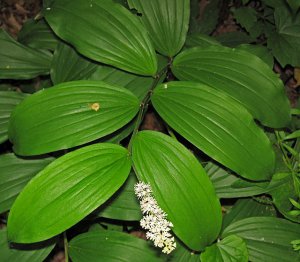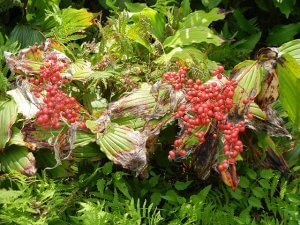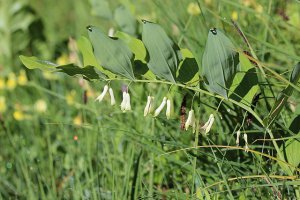False Solomon’s seal (Maianthemum racemosum) is a flowering plant that’s commonly found in many parts of the US and Canada, except for the Central US, although it’s still found in the Dakotas and parts of Texas. false Solomon’s seal typically grows in partial shade and deep, moist, soft soils. Examples of common areas where false Solomon’s seal can be found are woodland areas or shaded ravines.

False Solomon’s seal is native to the United States and its distribution is probably attributed to birds and mice that eat the berries that form and drop the seeds during defecation.

There are 2 subspecies of Maianthemum racemosum, amplexicaule, and racemosum. Amplexicaule is the western variety and can be identified by plants that have erect stems and leaves with a clasping, rounded base and upper leaves with tips with short points. Racemosum is the eastern variety that tends to have arching stems, leaves with a short petiole, and upper leaf-tips with an extended point 12–25 mm long. There is some overlap in occurrences of the varieties in the central part of both the US and Canada.
False Solomon’s seal gets its name from its resemblance to Solomon’s seal, however, the distinction is that the flowers hang from the ends of the stems instead of along the length of the stems. It is also known as Solomon’s plume, false feathery lily of the valley, or false spikenard.
False Solomon’s Seal Edibility and Culinary Use
The plant overall is edible, however, there are specific areas of the plant that you may want to consume in moderation. The berries for example are edible, but are bittersweet and can have a laxative effect if consumed in large quantities. These berries start out with a pale, speckled appearance and as they ripen will turn a deep ruby red color. The berries contain a sweet, jelly-like layer below the skin along with the rock-hard seeds which may be difficult to consume and most people will spit out.

The young shoots that appear in the spring are quite palatable and provide a taste similar to that of asparagus (they also happen to be in the asparagus family). Cooking the shoots is as easy as steaming them for a couple of minutes until they are crisp and tender. You can also blanch them, but for no longer than a minute or they will become mushy like overcooked asparagus.
Once the plants are mature, the leaves and stalks become quite bitter, and even herbivores such as deer will only occasionally munch on them.
The roots can be consumed raw, however, they are quite tough and fibrous. You can cut them into small ½ inch sections and boil them to make them easier to chew. Either raw or boiled, they have a sweet, nutty taste.
False Solomon’s Seal Health Benefit
False Solomon’s seal has been used by Native Americans for centuries to treat many different ailments. One use is an expectorant to help treat coughing mucus. Chemicals in the roots are also great as a stool softener and for treating constipation. For treatment of both of these issues, you use the dried roots to create a tea for drinking.
You can also use the false Soloman’s seal roots mixed with alcohol to create a tincture that can be used to treat arthritis, stiff or improperly stretched joints and ligaments, headaches, and upset stomach.
Using false Solomon’s seal in a tea brewed from the leaves you can treat skin rashes and itching by applying it topically.
Native Americans would also make an effusion using the dried roots to stun fish and make it easier for them to harvest them from streams.
False Solomon’s Seal Cautions
One of the major cautions you should take with false Solomon’s seal is in its proper identification. It closely resembles its relative of the Lily family, Solomon’s seal. Solomon’s seal’s berries and leaves are poisonous and should not be consumed. To avoid confusion, make sure that you correctly identify the plume of flowers at the end of the stem of false Solomon’s seal from the flowers that hang along the stem from Solomon’s seal.

False Solomon’s seal berries can have a laxative effect when consumed in large quantities. If you don’t consume them in moderation, it could cause you to have frequent and possibly unpleasant trips to the bathroom during consumption.
Conclusion
False Solomon’s seal is an edible plant that grows in the majority of the US with slight differences found in the Eastern and Western varieties. It’s been used by Native Americans as a food source and for the treatment of ailments such as cough, mucus, constipation, upset stomach, arthritis, stiff joints, itchy skin, and rashes.
This member of the asparagus and lily families can be a great addition to your foraged meal, but be very careful not to confuse it with its close relative, Solomon’s seal, which is very poisonous. Pay close attention to the location of the flowers on the stalks in order to avoid confusion.
—————
Written by Jared DeValk
Jared DeValk is an author, writer, and entrepreneur who in his free time can be caught hiking, planting berry bushes, or doing home repairs and improvements. Jared's varied life experience and passion for research empassions him to write knowledgeably about many topics such as , Health & Wellness, Real Estate, Finance, Business, Cryptocurrency, Home Improvement, Agriculture, Camping/Hiking, and many more. Jared can be reached directly for speaking, marketing, and writing inquiries at JaredDeValk.com.
See our privacy policy for more information about ads on this site
Many of our readers find that subscribing to Eat The Planet is the best way to make sure they don't miss any of our valuable information about wild edibles.






